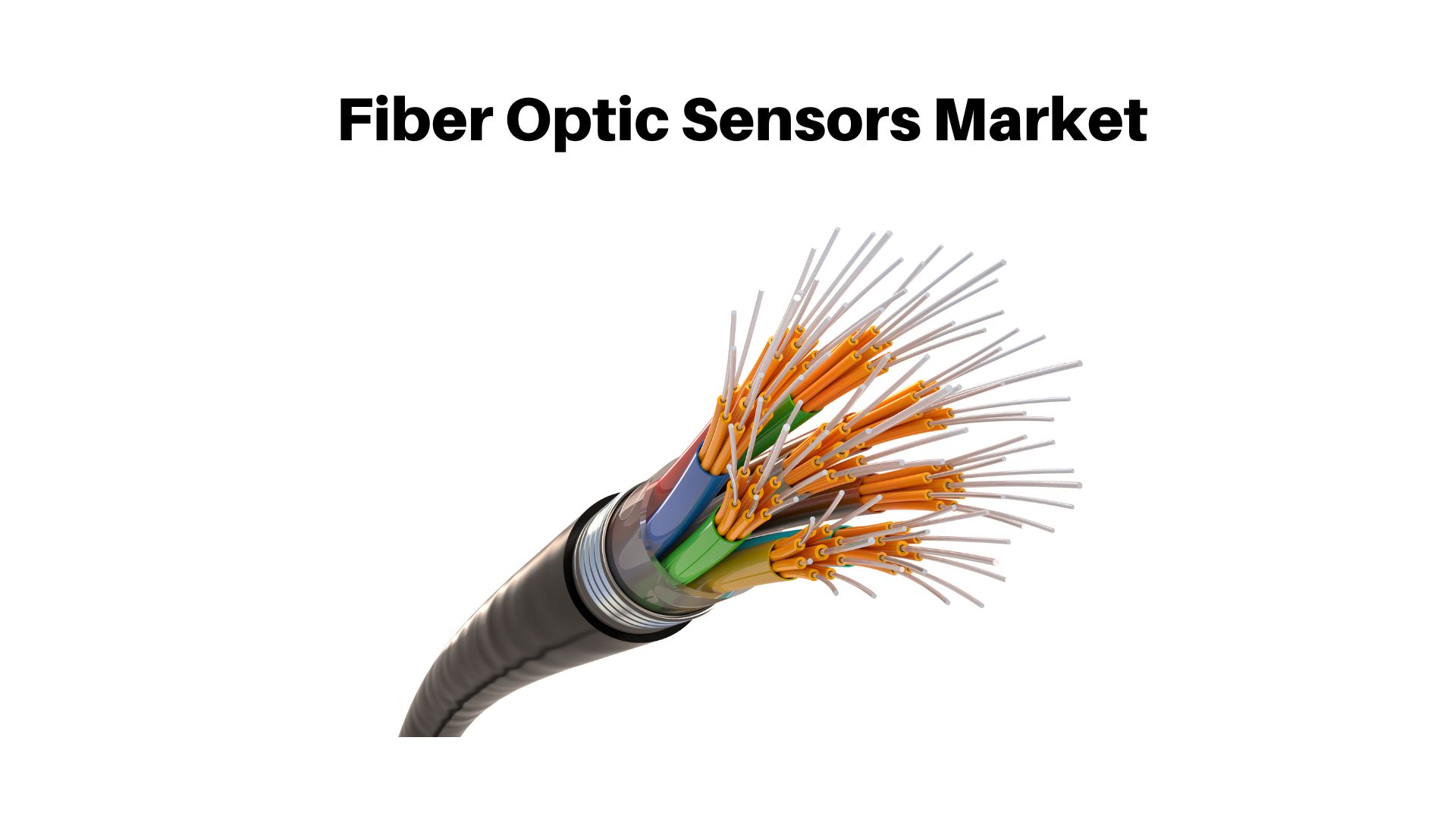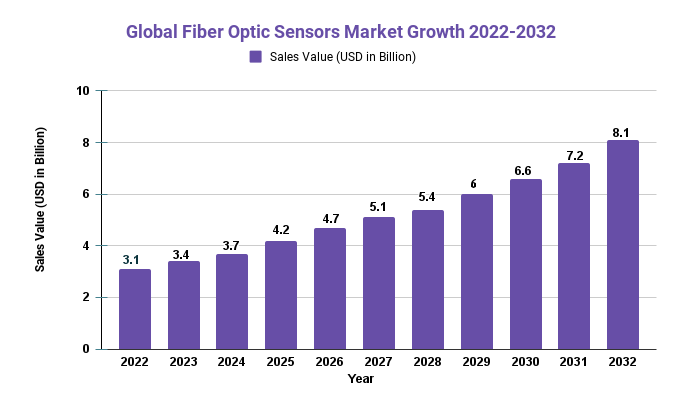Fiber Optic Sensors Market Economic Growth CAGR of 10.5%, 2022-2032

Page Contents
Market Overview
The Fiber Optic Sensors Market size is expected to be worth around USD 8.1 Bn by 2032 from USD 3.1 Bn in 2022, growing at a CAGR of 10.5% during the forecast period from 2022 to 2032.
Fiber optic sensors are becoming more and more popular across various industries due to their superior ability to detect changes in temperature, pressure, and strain with greater precision than traditional sensors. As industries seek more dependable and efficient methods of monitoring and controlling their operations, the market is expected to experience substantial growth over the coming years.
One factor fueling the growth of the fiber optic sensors market is an increasing need for smart structures. These structures use a network of fiber optic sensors to monitor structural integrity and adjust accordingly when conditions such as vibration or temperature change. This technology has found applications in numerous fields like aerospace, civil engineering, and energy production where they help prevent costly damage while providing safety.
Request For Sample Report Here: https://market.us/report/fiber-optic-sensors-market/request-sample/

Key Takeaways
- The global fiber optic sensors market is expected to experience rapid growth over the coming years, thanks to increasing demand from industries such as oil and gas, aerospace and defense, and healthcare.
- Fiber optic sensors offer a distinct advantage over traditional sensors in that they are able to measure multiple parameters simultaneously and accurately even in harsh conditions, making them ideal for use in various industrial applications.
- The oil and gas industry is expected to be the leading end-user segment for fiber optic sensors, due to their increasing application in pipeline monitoring, flow measurement, and temperature sensing.
- The aerospace and defense sector is a prime customer of fiber optic sensors, as they are employed in numerous applications such as structural health monitoring, strain measurement, and temperature sensing in aircraft, and other defense systems.
- The healthcare sector is expected to be the fastest-growing segment of the fiber optic sensors market, driven by increasing demand for these sensors in medical diagnosis and treatment applications.
- North America is expected to dominate the global market, due to the presence of key players and the growing adoption of fiber optic sensors across various industrial applications.
- Some of the major players operating in the global market include Micron Optics, Honeywell, FISO Technologies, Omron, FBGS TECHNOLOGIES GMBH, Proximion, Smart Fibres Limited, Sensornet, ITF Labs / 3SPGroup, Keyence, IFOS, NORTHROP GRUMMAN, O/E LAND, Inc, KVH, Photonics Laboratories, Chiral Photonics, FBG TECH, OPTOcon GmbH, Redondo Optics, Broptics
Regional Analysis
North America is expected to dominate the global fiber optic sensors market during the forecast period due to the number of key players present and the increasing adoption of fiber optic sensors across various industrial applications such as oil & gas, aerospace & defense, and healthcare.
Europe is expected to experience significant growth in the fiber optic sensors market due to increasing demand from industries such as healthcare, automotive, aerospace & defense.
The Asia-Pacific region is expected to experience the fastest growth in the fiber optic sensors market during the forecast period. This can be attributed to the rising demand for fiber optic sensors in countries such as China, India, and Japan due to their increasing industrialization and infrastructure development.
Latin America The fiber optic sensors market in Latin America is expected to experience steady growth over the forecast period, due to the increasing adoption of fiber optic sensors across various industrial applications such as oil & gas and healthcare.
Middle East and Africa The fiber optic sensors market in the Middle East and Africa are expected to experience substantial growth over the forecast period, driven by increasing demand for these sensors in the oil and gas industry of the region.
Overall, the global fiber optic sensors market is projected to experience significant growth throughout the forecast period due to rising demand from various industries and the advantages of fiber optic sensors over traditional sensors.
Browse the summary of the report and Complete Table of Contents (TOC): https://market.us/report/fiber-optic-sensors-market/table-of-content/
Drivers
Fiber optic sensors are finding increasing demand across a variety of industries, such as oil and gas, aerospace/defense, healthcare, and automotive. This is largely due to the advantages that fiber optic sensors possess over traditional sensors like high accuracy, immunity from electromagnetic interference, and durability in harsh conditions. Growing Demand for Structural Health Monitoring, Fiber optic sensors is increasingly being utilized for structural health monitoring in industries such as aerospace and defense, civil engineering, and power generation. This trend is being driven by a need to enhance safety while decreasing maintenance expenses.
Fiber optic sensors are seeing increasing adoption in the oil and gas industry, due to their capacity for monitoring pipeline integrity, flow measurement, and temperature sensing in harsh environments. As a result, demand for fiber optic sensors in this sector is expected to grow at an exponential rate. Fiber optic sensors in healthcare, The healthcare sector is rapidly becoming a major end-user of fiber optic sensors, due to their growing importance for medical diagnosis and treatment applications.
Technological Advancements, The rapid advancements in fiber optic technology, such as the creation of advanced optical fibers and novel sensing methods, are propelling the growth of the fiber optic sensors market. Increased Infrastructure Investments, The increasing investments in infrastructure development across various regions, especially Asia-Pacific, are fueling the growth of the market of fiber optic sensors as these sensors are increasingly being employed for various infrastructure projects.
Overall, the market of fiber optic sensors is expected to experience continued growth over the coming years due to these and other factors.
Restraints
High cost of installation and maintenance, The high cost of installation and upkeep for fiber optic sensors poses a major hurdle to market adoption, particularly among small and medium-sized enterprises. This could limit their adoption, particularly in emerging economies. Limited Technical Competence and Knowledge, Lacking the technical proficiency and technical know-how necessary for the installation and upkeep of fiber optic sensors poses a problem, particularly in developing countries where skilled labor is scarce.
Lack of Standardization The absence of fiber optic sensor standards poses a major obstacle, particularly with respect to calibration and interoperability. This could limit their adoption, particularly in industries such as healthcare where accuracy and dependability are essential factors. Competition from Alternative Technologies The fiber optic sensors market is facing competition from alternative technologies such as wireless sensors, which are becoming more widely used in various industrial applications.
Regulatory Challenges, The regulatory obstacles associated with using fiber optic sensors in certain applications, such as medical devices and aerospace/defense systems, could impede their widespread adoption. Limitations of Fiber Optic Technology, Fiber optic sensors may experience performance issues due to signal attenuation and dispersion, especially in applications requiring long-range sensing.
Overall, these obstacles could impede the growth of the market of fiber optic sensors, particularly in certain regions and industries.
Opportunities
Increased Demand from Emerging Economies The rapidly industrializing and infrastructure development in emerging economies such as India, China, and Brazil offer significant growth prospects for the market of fiber optic sensors. The rising adoption of fiber optic sensors in these regions is anticipated to fuel its expansion. Advancements in technology The continuous improvements to fiber optic technology, such as the development of advanced optical fibers and novel sensing techniques, are anticipated to fuel growth in the market by enabling new applications and optimizing existing ones.
Growing Demand from the Healthcare Sector The healthcare sector is a rapidly expanding end-user of fiber optic sensors, driven by their increasing use in medical diagnosis and treatment applications. This presents significant growth prospects for the market. Increased Infrastructure Investments, The growing infrastructure development activities across various regions, particularly Asia-Pacific, offer significant growth prospects for the market as these sensors are increasingly utilized in various infrastructure projects.
The growing use of fiber optic sensors in smart cities, especially in developed countries, offers significant growth prospects for the fiber optic sensors market. Increased Use in the Automotive Industry, The growing application of fiber optic sensors within the automotive sector, particularly for advanced driver assistance systems (ADAS) and other safety-critical applications, presents significant growth prospects for the market.
Overall, these opportunities are expected to fuel the growth of the market over the coming years, particularly in emerging economies and industries such as healthcare, automotive, and infrastructure development.
Challenges
Installation and Maintenance Costs The high cost of installation and upkeep for fiber optic sensors poses a major barrier in the market, particularly for small and medium-sized enterprises (SMEs). This could inhibit their adoption, particularly in emerging economies. Lack of Technical Knowledge and Expertise, Lacking technical know-how to install and maintain fiber optic sensors is a major obstacle, particularly in developing countries where skilled labor is scarce.
Lack of Standardization, The lack of standards in fiber optic sensors poses a major obstacle, particularly with regard to calibration and interoperability. This could impede their adoption, particularly in industries such as healthcare where accuracy and dependability are essential requirements. Competition from Alternative Technologies The market is facing competition from alternative technologies such as wireless sensors, which are increasingly finding use in various industrial applications.
Regulatory Barriers The regulatory obstacles associated with using fiber optic sensors in certain applications, such as medical devices and aerospace/defense systems, could impede their widespread adoption. Limitations of Fiber Optic Technology Fiber optic sensors have certain inherent limitations, such as signal attenuation and dispersion, that could limit their performance in certain applications requiring long-range sensing. Impact of COVID-19 Pandemic on Fiber Optic Sensor Market The COVID-19 pandemic has had a substantial effect on the fiber optic sensors market, particularly due to supply chain disruptions, reduced demand from certain end-user industries, and delays in infrastructure development projects.
Report Scope
| Report Attribute | Details |
| The market size value in 2022 | USD 3.1 Bn |
| Revenue forecast by 2032 | USD 8.1 Bn |
| Growth Rate | CAGR Of 10.5% |
| Regions Covered | North America, Europe, Asia Pacific, Latin America, and Middle East & Africa, and the Rest of the World |
| Historical Years | 2017-2022 |
| Base Year | 2022 |
| Estimated Year | 2023 |
| Short-Term Projection Year | 2028 |
| Long-Term Projected Year | 2032 |
Key Market Segments:
Type
- Intensity Modulated Fiber Optic Sensors
- Phase Modulated Fiber Optic Sensors
- Wavelength Modulated Fiber Optic Sensors
- Polarization Modulated Fiber Optic Sensors
Application
- Oil & Gas
- Buildings and Bridges
- Tunnels
- Dams
- Heritage structures
- Power grid
- Aerospace Applications
Key Market Players included in the report:
- Micron Optics
- Honeywell
- FISO Technologies
- Omron
- FBGS TECHNOLOGIES GMBH
- Proximion
- Smart Fibres Limited
- Sensornet
- ITF Labs / 3SPGroup
- Keyence
- IFOS
- NORTHROP GRUMMAN
- O/E LAND, Inc
- KVH
- Photonics Laboratories
- Chiral Photonics
- FBG TECH
- OPTOcon GmbH
- Redondo Optics
- Broptics
Frequently Asked Questions
What is the market study period?
The Fiber Optic Sensors Market is studied from 2017 – 2032.
What is the growth rate for the market of fiber optic sensors?
The Fiber Optic Sensors Market is growing at a CAGR of 10.5%
Who are the major players in the Fiber Optic Sensors industry?
Micron Optics, Honeywell, FISO Technologies, Omron, FBGS TECHNOLOGIES GMBH, Proximion, Smart Fibres Limited, Sensornet, ITF Labs / 3SPGroup, Keyence, IFOS, NORTHROP GRUMMAN, O/E LAND, Inc, KVH, Photonics Laboratories, Chiral Photonics, FBG TECH, OPTOcon GmbH, Redondo Optics, Broptics
The team behind market.us, marketresearch.biz, market.biz and more. Our purpose is to keep our customers ahead of the game with regard to the markets. They may fluctuate up or down, but we will help you to stay ahead of the curve in these market fluctuations. Our consistent growth and ability to deliver in-depth analyses and market insight has engaged genuine market players. They have faith in us to offer the data and information they require to make balanced and decisive marketing decisions.